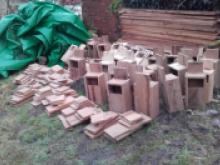For the past few weeks the volunteers and I have been constructing artificial rot boxes. This is an innovative technique to encourage dead wood loving insects to breed. The boxes are designed to replicate rot holes on ancient trees – a feature that is massively important to our woodland biodiversity but unfortunately very rare nowadays.
The boxes are very similar to bird nest boxes, but slightly bigger and we seal the joints to make sure they hold water. Then we fill them with wood chipping, sawdust, small sticks, leaf litter and any other detritus that might be hanging around.
As the box fills with rainwater aquatic microbes will start to digest all the wood chipping and other material in the box. Firstly fungi will break apart lignin cellulose complexes – these are compounds where cellulose (often called fibre when we talk about diets and such like) is bound to a molecule of lignin which is a natural form of microscopic cement that gives wood its strength and durability. Bacteria are then able to secrete their digestive enzymes onto the cellulose and digest it to give them all the nutrients they need to grow. As they do this they can give off other chemicals that feed other species of bacteria. All these fungi and bacteria floating around attract larger microbes called protists that swim through the water and catch and consume the smaller bacteria. So, long story short, you end up with a soup of rotting wood supporting a whole microscopic ecosystem.
As the rotting process continues flying adult insects will be drawn to the smell and will lay their eggs in the soup of decomposing material. The larvae that hatch from the eggs will then feed on the colonies of bacteria and fungi usually by a filtering method, like a tiny whale! The larvae then pupate and when they emerge as adults they fly out into the wider world.
And as they fly around searching for another rot hole to lay their own eggs and begin the process again they’ll be pollinating flowers and many will become a well needed meal for some of our rare woodland birds like redstart and flycatchers.
Bearing in mind rot holes would naturally take a hundred years or more to develop on a given tree, we’re building 250 boxes all together which will be distributed across the Churnet Valley. This means we can provide 250 rot holes without having to damage a single tree in the process. The first 30 boxes will be mounted on site this week. It’s really rewarding to contribute to such a new technique.


